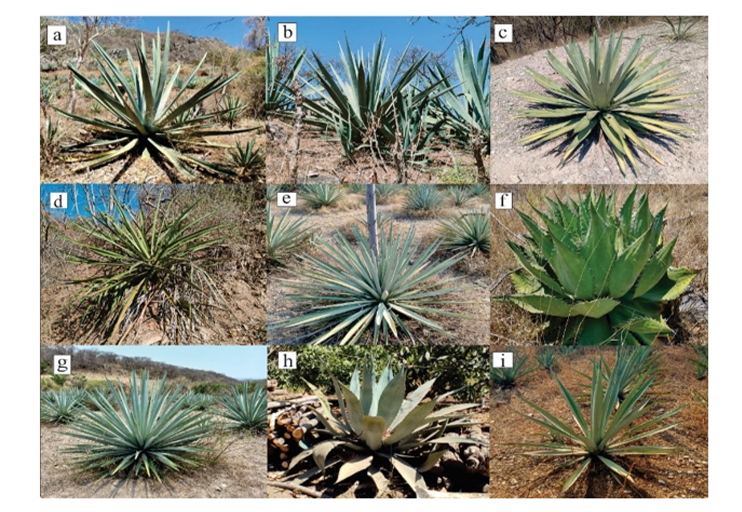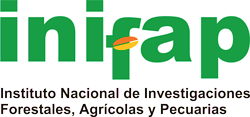Morphometric characterization of mezcal agaves from the Northern Region of Guerrero
DOI:
https://doi.org/10.29312/remexca.v16i4.3729Keywords:
agave, linear discriminant analysis, morphometrics, principal component analysisAbstract
The current knowledge of farmers in the Northern Region of Guerrero about the identification of agave species and varieties used in mezcal production is limited. By not knowing the scientific name of these species, they are prevented from accessing information on forms of reproduction, management and byproducts, as well as the certification processes of agave plantations for mezcal production. This research aimed to characterize the morphometry of mezcal agaves and identify traits that can be used for their identification. The research was conducted from 2016 to 2023, collecting 230 agave specimens in 31 localities in the Northern Region of Guerrero. Twenty-three morphometric traits were measured, which were entered into a database in Microsoft Excel®. Principal component analysis and linear discriminant analysis were performed in the R software version 4.0.3. The first five principal components explained 79.59% of the variation. Linear discriminant analysis required two discriminant functions to explain 89% of the variation. The traits that contributed the most in the principal component analysis were tooth uniformity, leaf margin, and length of tooth in the middle of the leaf. In linear discriminant analysis, the traits that contributed the most were wider leaf width, leaf length, and leaf base width. The identification of these species and varieties will make it easier for farmers to certify their agave plots and give added value to the mezcal.
Downloads
References
Alducin-Martínez, C.; Ruiz-Mondragón, K. Y.; Jiménez-Barrón, O.; Aguirre-Planter, E.; Gasca-Pineda, J.; Eguiarte, L. E. and Medellín, R. A. 2023. Uses, knowledge and extinction risk faced by Agave species in Mexico. Plants. 12(1):1-37. Doi.org/10.3390/plants12010124.
Álvarez-Duarte, M. C.; García-Moya, E.; Suarez-Espinosa, J.; Luna-Cavazos, M. y Rodríguez-Acosta, M. 2018. Conocimiento tradicional, cultivo y aprovechamiento del maguey pulquero en municipios de Puebla y Tlaxcala. Polibotánica. 0(45):205-222. Doi.org/10.18387/polibotanica.45.15.
Arzaba-Villalba, C. R.; Cházaro-Bazáñes, M.; Luna-Cavazos, M. y García-Moya, E. 2023. Análisis morfométrico de Agave sensu stricto (Asparagaceae: agavoideae) en Veracruz y áreas adyacentes de Puebla, México. Polibotánica. 56:39-59. Doi.org/1010.18387/polibotanica.56.3.
Barrientos-Rivera, G.; León-Esparza, I. E.; Segura-Pacheco, H. R.; Talavera-Mendoza, Ó.; Laura-Sampedro, R. M. y Hernández-Castro, E. 2019. Caracterización morfológica de Agave angustifolia y su conservación en Guerrero, México. Revista Mexicana de Ciencias Agrícolas. 20(1):1-14. Doi.org/10.29312/remexca.v10i3.1554.
Chavez-Parga, M. D. C.; Pérez-Hernández, E. y González-Hernández, J. C. 2016. Revisión del agave y el mezcal. Revista Colombiana de Biotecnología. 18(1):148-164. Doi.org/10.15446/rev.colomb.biote.v18n1.49552.
Delgado-Lemus, A., Torres-García, I., Blancas, J., y Casas, A. 2014. Vulnerability and risk management of Agave species in the Tehuacán Valley, México. Journal of ethnobiology and ethnomedicine. 10(1):1-15. Doi.org/10.1186/1746-4269-10-53.
Figueredo-Urbina, C. J.; Casas, A. y Torres-García, I. 2017. Morphological and genetic divergence between Agave inaequidens, A. cupreata and the domesticated A. hookeri. analysis of their evolutionary relationships. Plos One. 12(11):1-24. https://doi.org/10.1371/journal.pone.0187260.
Figueredo-Urbina, C. J.; Álvarez-Ríos, G. D.; García-Montes, M. A. y Octavio-Aguilar, P. 2021. Morphological and genetic diversity of traditional varieties of agave in Hidalgo State, Mexico. Plos One. 16(7):1-24. Doi.org/10.1371/journal.pone.0254376.
Fragoso-Gadea, T.; Gutiérrez, A.; Coronado, M. L.; Terrazas, T.; Ramos-Clamon, G.; Vázquez-Moreno, L.; Álvarez-Bajo, O. y Esqueda, M. 2021. Poblaciones silvestres de Agave angustifolia (Asparagaceae) de Sonora, México: variación morfológica y contenido de azúcares. Acta Botánica Mexicana. 128: e1889, 1-16. https://doi.org/10.21829/abm128.2021.1924.
García-Mendoza, A. J. 2011. Agavaceae. Flora del Valle de Tehuacán-Cuicatlán. Medina-Lemos R. Ed. Comisión Nacional para el Conocimiento y Uso de la Biodiversidad Instituto de Biología-Universidad Nacional Autónoma de México (UNAM). Fascículo 88. México, DF. 95 p.
García-Mendoza, A. J.; Martínez, I. S. F., y Gutiérrez, D. S. 2019. Cuatro especies nuevas de agave (Asparagaceae, Agavoideae) del sur de México. Acta Botánica Mexicana. 126(e1461):1-18. doi.org/10.21829/abm126.2019.1461.
Gentry, H. S. 1982. Agaves of Continental North American. The University of Arizona Press. Tucson. 670 p.
Gonzalo, R.; Aedo, C.; Nickrent, D. L. y García, M. A. 2012. A numerical taxonomic investigation of Stipa Sec. Smirnovia and Sect. Subsmirnovia (Poaceae). Systematic Botany. 37(3): 665-670. doi.org/10.2307/41515154.
Gutiérrez, J.; Terrazas, T. y Luna-Vega, I. 2017. Morphometric analysis of Milla biflora (Asparagaceae: brodieaoideae), with an identification key for Milla. Plant Ecology and Evolution. 150(1):76-86. Doi.org/10.5091/plecevo.2017.1276.
Huerta-Zavala, J. 2018. Variación morfológica y áreas potenciales de poblaciones del complejo Agave angustifolia en el estado de Guerrero. Tesis de Maestría en Ciencias agropecuarias y gestión local. Universidad Autónoma de Guerrero. Iguala de la Independencia. 46-66 pp.
Mora-López, J. L.; Reyes-Agüero, J. A.; Flores-Flores, J. L.; Peña-Valdivia, C. B. y Aguirre-Rivera, J. R. l. Variación morfológica y humanización de la sección Salmianae del género Agave. Agrociencia. 45(4):465-477.
R Core Team 2020. R: a language and environment for statistical computing. R foundation for statistical computing, Vienna, Austria. https://www.R-project.org/.
Rivera Lugo, M.; García Mendoza, A. J.; Simpson, J.; Solano, E.; y Gil-Vega, K. 2018. Implicaciones taxonómicas de la variación morfológica y genética de poblaciones cultivadas y domesticadas del complejo Agave angustifolia (Agavoideae, Asparagaceae) en Oaxaca, México. Plant Systematics and Evolution. 304(8):969-979. Doi.org/10.1007/s00606¬018¬1525¬0.
Vázquez-Pérez, N.; Blancas, J.; Torres-García, I.; García-Mendoza, A.; Casas, A.; Moreno-Calles, A. I.; Maldonado-Almanza, B. y Rendón-Aguilar, B. 2020. Conocimiento y manejo tradicional de Agave karwinskii en el sur de México. Botanical Sciences. 98(2):328-347. Doi.org/10.17129/botscI.2421.
Weihs, C.; Ligges, U.; Luebke, K. y Raabe, N. 2005. Klar analyzing German business cycles. Ed. Data analysis and decision support, Springer-Verlag, Berlin. 335-343 pp. Doi.org/10.1007/3-540-28397-8-36.

Published
How to Cite
Issue
Section
License
Copyright (c) 2025 Revista Mexicana de Ciencias Agrícolas

This work is licensed under a Creative Commons Attribution-NonCommercial 4.0 International License.
The authors who publish in Revista Mexicana de Ciencias Agrícolas accept the following conditions:
In accordance with copyright laws, Revista Mexicana de Ciencias Agrícolas recognizes and respects the authors’ moral right and ownership of property rights which will be transferred to the journal for dissemination in open access. Invariably, all the authors have to sign a letter of transfer of property rights and of originality of the article to Instituto Nacional de Investigaciones Forestales, Agrícolas y Pecuarias (INIFAP) [National Institute of Forestry, Agricultural and Livestock Research]. The author(s) must pay a fee for the reception of articles before proceeding to editorial review.
All the texts published by Revista Mexicana de Ciencias Agrícolas —with no exception— are distributed under a Creative Commons License Attribution-NonCommercial 4.0 International (CC BY-NC 4.0), which allows third parties to use the publication as long as the work’s authorship and its first publication in this journal are mentioned.
The author(s) can enter into independent and additional contractual agreements for the nonexclusive distribution of the version of the article published in Revista Mexicana de Ciencias Agrícolas (for example include it into an institutional repository or publish it in a book) as long as it is clearly and explicitly indicated that the work was published for the first time in Revista Mexicana de Ciencias Agrícolas.
For all the above, the authors shall send the Letter-transfer of Property Rights for the first publication duly filled in and signed by the author(s). This form must be sent as a PDF file to: revista_atm@yahoo.com.mx; cienciasagricola@inifap.gob.mx; remexca2017@gmail.
This work is licensed under a Creative Commons Attribution-Noncommercial 4.0 International license.


